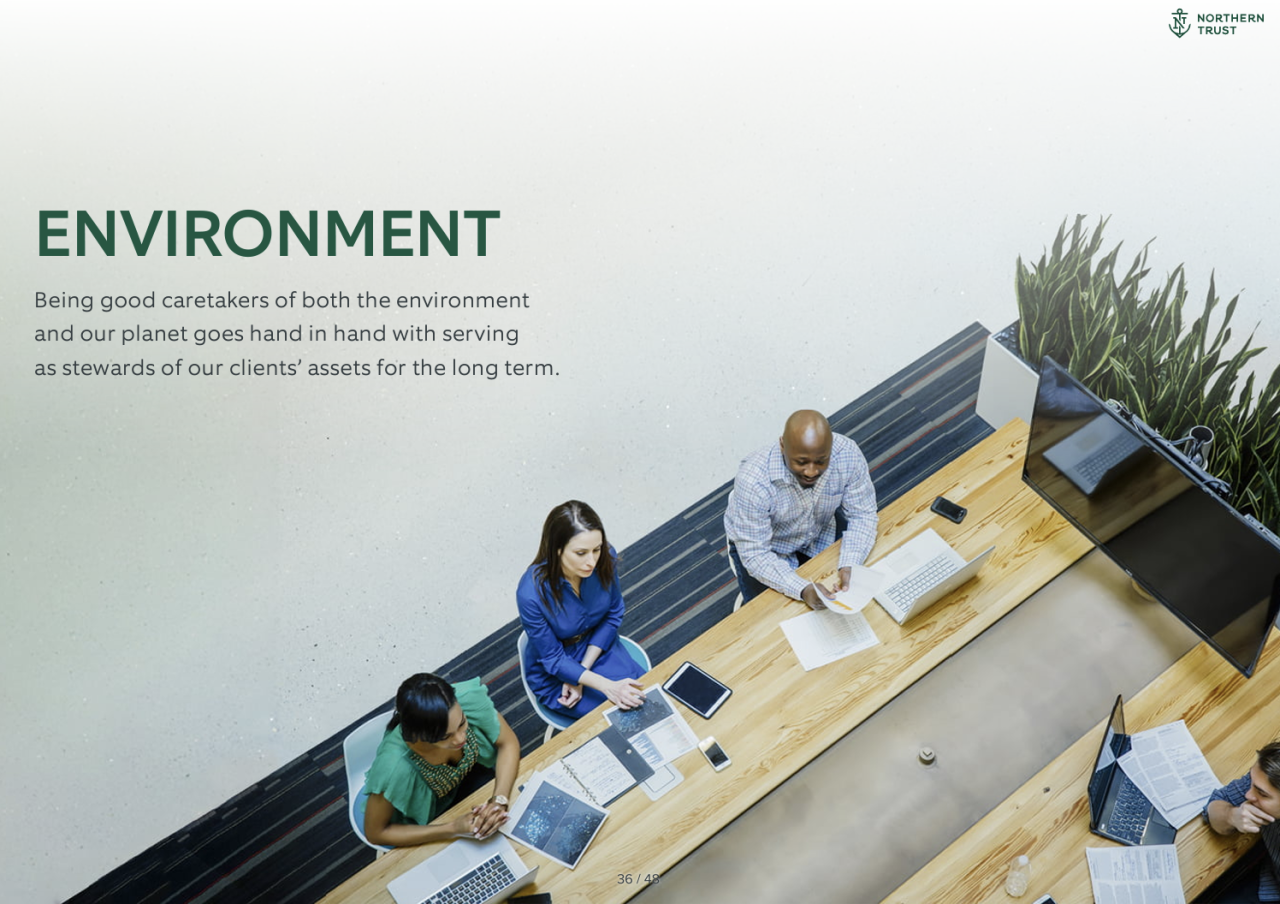A Strategy for Sustainable Operations at Northern Trust
- None.
- None.
Insights
From an environmental sustainability perspective, Northern Trust's commitment to reducing its carbon footprint and aligning with the GHG Protocol signifies a strategic move towards operational efficiency and corporate responsibility. The emphasis on LEED and BREAM certifications demonstrates a tangible effort to adhere to recognized environmental standards, which not only reduces operational costs through energy savings but also enhances the company's reputation among environmentally conscious stakeholders.
Moreover, the partnership with Climate Vault indicates a proactive approach in addressing climate change by leveraging market mechanisms to achieve net-zero carbon emissions. This could potentially offer Northern Trust a competitive advantage as investors and clients increasingly favor businesses with strong environmental credentials.
From a financial standpoint, Northern Trust's initiatives to reduce energy consumption by over 30% can lead to significant cost savings, thereby improving profit margins and potentially increasing shareholder value. The reduction in emissions by more than 5% since 2019 is indicative of a successful implementation of sustainability measures, which may also mitigate risks associated with future regulatory changes concerning environmental impact.
The collaboration with Climate Vault could be seen as a strategic investment into carbon offsetting, which may not only help in meeting the net-zero target but also position Northern Trust favorably in a market that is increasingly sensitive to climate-related financial disclosures and investment risks.
From a risk management perspective, Northern Trust's sustainability efforts are crucial in managing climate-related risks that can have far-reaching implications on the company's operations and supply chain. The proactive measures to track and manage environmental performance, along with the commitment to net-zero carbon emissions, are likely to reduce exposure to both transitional and physical risks associated with climate change.
Furthermore, the detailed tracking and reduction of GHG emissions align with the Task Force on Climate-related Financial Disclosures (TCFD) recommendations, which are becoming a standard for investors assessing the climate risks of their portfolios. By aligning with these frameworks, Northern Trust is not only mitigating risk but also ensuring transparency with stakeholders, which is critical in maintaining investor confidence.
NORTHAMPTON, MA / ACCESSWIRE / January 5, 2024 / Northern Trust
Originally published in Northern Trust's 2022 Sustainability Report
In addition to developing sustainable investment strategies and innovative products for our clients that reflect and advance their environmental priorities, we manage climate-related risks, realize investment opportunities in the transition to a greener world, and also embed sustainability principles and practices within our business operations.
The fundamental principle of sustainability is to meet the needs of the present generation without compromising the ability of future generations to meet their needs. We align our business to this concept by integrating environmental considerations into company-wide processes, continually improving our business practices and delivering tangible, positive results related to the environment.
It is our desire to preserve the environment for future generations, as we know the long-term viability of our business and the success of our clients are tied to the health and well-being of our planet. That's why we commit to protecting the environment and mitigating negative environmental impacts from our operations.
In managing our real estate portfolio, related procurement and facilities services, Northern Trust's Workplace Services function works to reduce the negative environmental impacts of our supply chain. We use energy to power our data centers and facilities, the majority of which are in North America. As a result, the bulk of our greenhouse gas (GHG) emissions come from our North American operations. Since we began tracking our carbon footprint (comprised of the carbon dioxide equivalent of all GHGs produced from our operations), we have improved our data collection processes and calculation methodologies to align with the GHG Protocol.
Working closely with our building managers, Northern Trust follows the environmentally friendly building strategies and practices outlined by the U.S. Green Building Council's Leadership in Energy and Environmental Design (LEED) program. More than 12 percent of our buildings are either LEED- or Building Research Establishment Environmental Assessment Method (BREAM)-certified. In addition, we use tracking programs to monitor and manage our environmental performance and calculate our annual carbon footprint.
Realizing that climate impacts threaten more than supply chains and physical infrastructure, we made the commitment to be net-zero carbon by 2050, using our 2019 baseline. As of Dec. 31, 2022, we have reduced the emissions of our business operations by more than 5 percent, and reduced our energy consumption by more than 30 percent. In 2022, Northern Trust worked with Climate Vault to reduce carbon emissions through a two-step approach. Climate Vault first purchases and "vaults" carbon emission allowances from government-regulated compliance markets. Because the number of permits is capped, keeping them off the market supports the avoidance of carbon dioxide emissions and provides a quantifiable, verifiable reduction in carbon pollution. Climate Vault will then leverage the value of the emission allowances to fund an equivalent or greater amount of carbon removals from new carbon dioxide removal (CDR) technologies through a bi-annual grant process. Additional information about our GHG emissions can be found in our Statement of GHG Emissions.
We are also continuing to expand the types of emissions on which we report, such as the recent additions of water and waste emissions data.
WATER AND WASTE
We began gathering data on water consumption and waste in our buildings in 2020. In 2022, 27 percent of our portfolio buildings were able to provide water-use data, representing nearly 48 metric tons of carbon dioxide equivalent (MtonCO2e)/year. This equates to a total of 59,987 kGal of water, or 2,528 gallons per partner.
Water
In our Limerick office, flush timers have been added to minimize the volume of water used for flushing. Taps/faucets are also spring loaded to enable automatic shut-off after use. Rainwater is also being collected in a rain barrel, and then used for maintenance of the grounds.
Similarly, in Luxembourg, rainwater collectors are being used to reduce water consumption and costs.
Waste
In 2022, 6,056 MtonCO2e was associated with waste. This equates to 14,580,765 kg of waste, giving an average of 614kg of waste per partner. Of this 14 million kg of waste- 7 percent was recycled, and 93 percent was trash. At Northern Trust, 31 sites, or 29 percent of total sites, report actual waste data. This is an increase of 4 percent of total sites that reported data versus 2021.
In India, all sites have moved to common centralized dustbins to dispose of waste in the office and have reduced approximately 80 percent of plastic garbage liners. Arecanut plates and cups are used in place of Styrofoam items, and Lowooden, single-use cutlery is used as an alternative to plastic. In Limerick and London, paper cups have been removed and replaced with travel mugs for partners. Likewise, in Dublin, paper cups have been replaced with porcelain mugs.
In 2022 we have made efforts across the entire portfolio to reduce our single-use plastic. We are more than 50 percent single-use plastic-free, when measured against our benchmark. In 2022, our three Chicago offices made the change from plastic utensils and straws to compostable ones.
We are also conducting a trial on the use of plastic free bin liners in some areas. Travel mugs were also given out to partners in our Chicago buildings in an effort to reduce single-use cups.
To reduce our water and waste footprint, we will continue to work with facilities teams across our portfolio to expand the number of locations supplying this data for our carbon emissions report.

View additional multimedia and more ESG storytelling from Northern Trust on 3blmedia.com.
Contact Info:
Spokesperson: Northern Trust
Website: https://www.3blmedia.com/profiles/northern-trust
Email: info@3blmedia.com
SOURCE: Northern Trust
View the original press release on accesswire.com
FAQ
What is Northern Trust's ticker symbol?
What is outlined in Northern Trust's 2022 Sustainability Report?
How much has Northern Trust reduced its business operations emissions by since 2019?
What is Northern Trust's net-zero carbon goal timeline?







